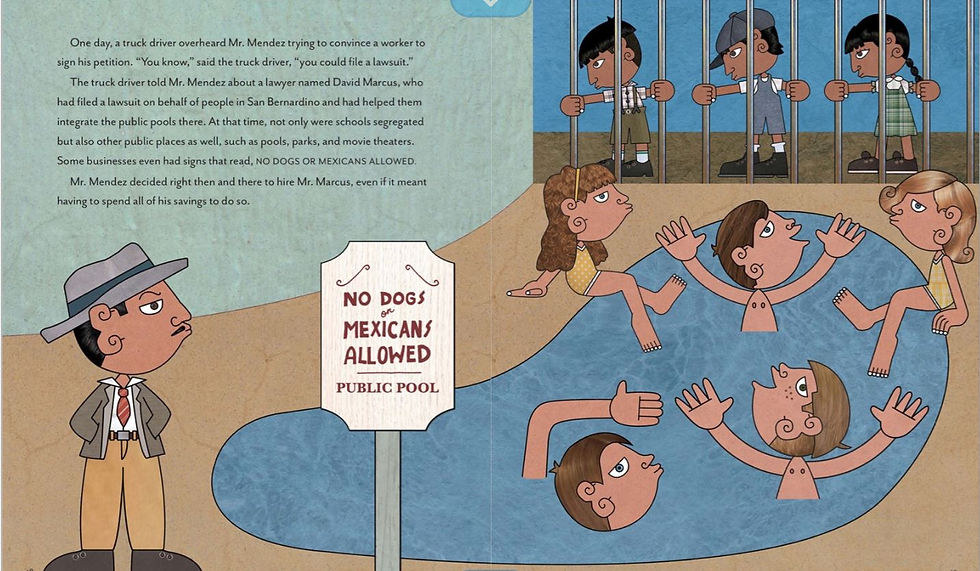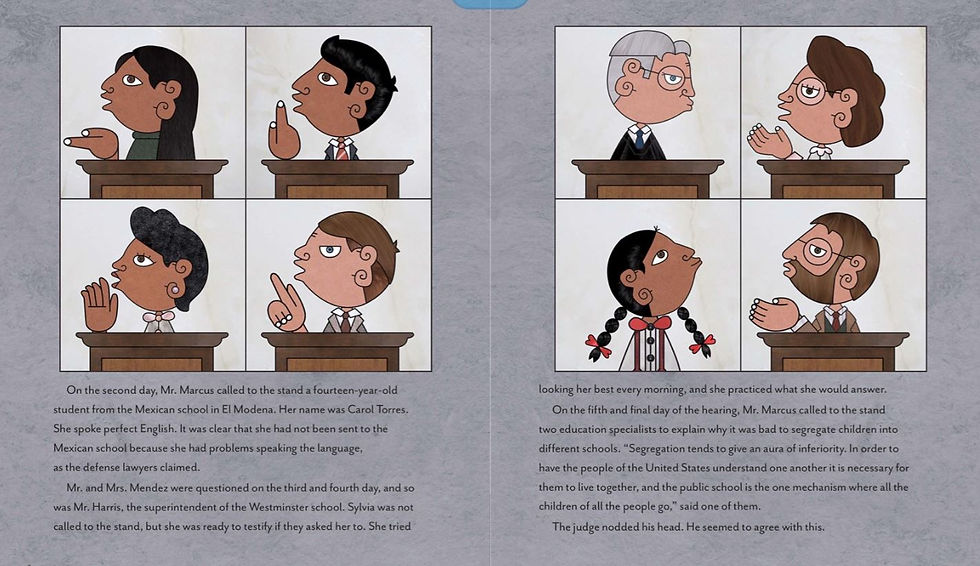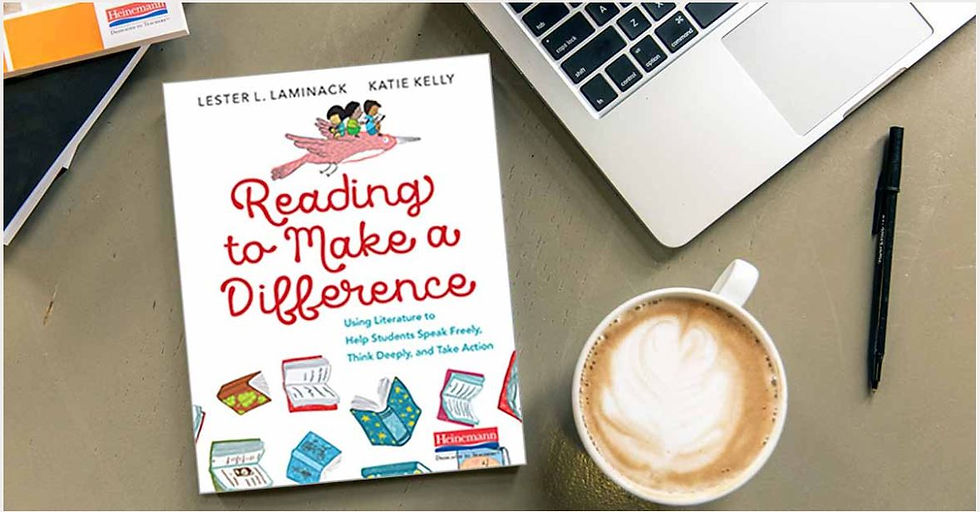Separate Is NEVER Equal
- harrisonse
- Oct 14, 2020
- 5 min read
Updated: Oct 16, 2020

Separate Is Never Equal is an astounding children’s book written and illustrated by Duncan Tonatiuh that discusses the discriminatory experiences Sylvia Mendez and her family experienced in segregated America. This book shares the story of Sylvia and her cousins embarking on the journey to receive an education that was fair and just, where they were not discriminated against because of the color of their skin. Since Sylvia’s cousins had a lighter complexion and an Italian last name they were permitted to attend the white school whereas Sylvia and her brothers were not. This unjust experience sparked a fire in the Mendez family, leading them to fight for an equal education for their children and those alike by filing a lawsuit. Although it took some time and deliberation, the Mendez family won their case and schools in their area were desegregated. It was not an easy fight and the battle was not over yet, but Sylvia walked the halls with her head held high, ignoring the remarks made by her classmates, because she knew that she deserved to be there just like any other child. This story was truly empowering because it shows how with passion and determination you can achieve great things to make a substantial difference in the world.
As I progressed through this story the ancient art style represented in Tonatiuh’s illustrations stood out to me because I have not often seen children’s books illustrated in this way. Through his graphic life writing he was able to expose and challenge stereotypes from the time period of the story using both the written text and his captivating illustrations. It is so important to provide students with access to a wide variety of diverse texts where several different groups of people are represented to combat the misrepresentations commonly portrayed in children’s literature. The common white-washed narrative of children’s literature can be damaging for members of minorities because they are rarely represented, and if they are it is commonly done inaccurately because the text is not authentic. Throughout the book you can see instances where these stereotypes are both recognized and combatted, making this quite a powerful story. In the following picture from the book you can see how Tonatiuh recognized the racial discrimination during that time.

In this image one thing in particular stood out to me. Although I noticed the children standing behind the fence because they were not allowed in and the white privilege being portrayed in this illustration, it was sign toward the front of the page that truly shocked me; “No Dogs or Mexicans Allowed.” I could not believe my eyes when I read that sign, is this truly how members of the LatinX community were viewed? Equated more so to dogs than people? This page is so impactful for the audience because it provides us with a window into the past to see how minoritized groups were viewed and treated. As I mentioned the author/illustrator also combats stereotypes in this book which can be seen in the following image.

During the trial one of the superintendents was sharing why he sent certain students to the Mexican school, stating that they needed to improve their English, to refine their social behavior, and to modernize their economic outlook, all of which were excuses to hide the true reason he kept students separate; because of the color of their skin. As the superintendent spoke, Sylvia sat in her seat outraged because of the lies that were being told. In the page I have included above from the book you can see one of these lies being countered when a student from the Mexican school takes the stand, speaking perfect English. The idea of segregation was also confronted in the quote “Segregation tends to give an aura of inferiority. In order to have the people of the United States understand one another it is necessary for them to live together, and the public school is one mechanism where all the children of all the people go” (p. 29). You could see the truth of this statement in the beginning of this story when a white student told Sylvia that she did not belong there. The student believed this because of the history of segregation of different races in schools whereas if schools were desegregated students would be more likely to see one another as equals. After this student said that to Sylvia she immediately felt ashamed, saying that she did not want to go to that school because the other children did not want her there. When she said this to her parents they asked her “Don’t you know that is why we fought” (p. 3)? This caused Sylvia to reflect on the events that happened, leading her to be able to attend this school. This fight was not something she could do on her own but with the help of her parents, other enraged members of the community, and a progressive lawyer they were able to make a huge difference that will forever be remembered. In the end, instead of admitting defeat because of the judgmental stares or offensive comments made by her classmates, she walked the halls with her head held high because she knew how important this fight for equality was. I admired this about Sylvia because I cannot imagine how intimidating it was being around people who hated you solely because of the color of your skin.
Mentor Text

Through reading chapter 5 of Reading to Make a Difference, I realized how important children’s literature can be when used as a tool to advocate for change. So many important conversations with students can begin through reading authentic children’s literature that represent marginalized groups authentically. More authors are rising that are members of a marginalized group, sharing their authentic stories about groups that are not commonly represented in children’s books, but these are stories and experiences that need to be shared and I am grateful they are taking the opportunity to do so. As I read this chapter I was amazed at the insights the students shared and questions they asked after hearing these stories, like Separate Is Never Equal. I also realized through reading this chapter that these important conversations cannot only happen with older students but with students of all ages. You can introduce lessons on these important topics through children’s books and further your lesson with other resources, such as photographs, videos, and other pieces of text so the topics are being shown using a wide range of modalities. These conversations may feel daunting at times, but they are crucial to the growth and understanding of your students, making it crucial that you have a diverse range of texts available to your students in your classroom library.
For more information about the author visit the link below:
Duncan Tonatiuh: http://duncantonatiuh.com/
As I was reading this book I began thinking about how much hate is in the world and how unfair it is. This made me think of this song that asks us "Where is the love" discussing the hatred we share towards one another rather than acceptance. I thought this song would be quite fitting for a unit that discusses unjust experiences people go through.
Other Resources:
Interview with Sylvia Mendez:



Comments